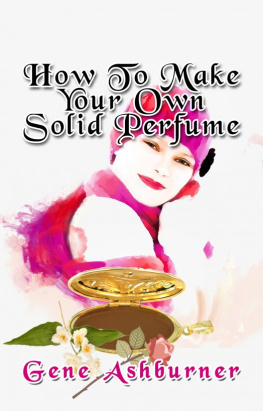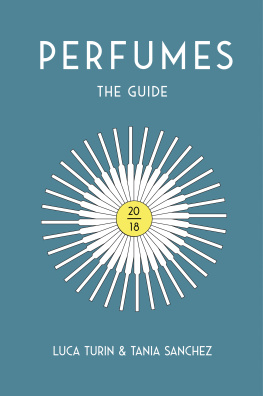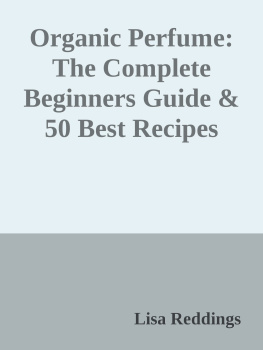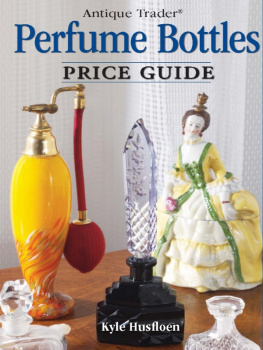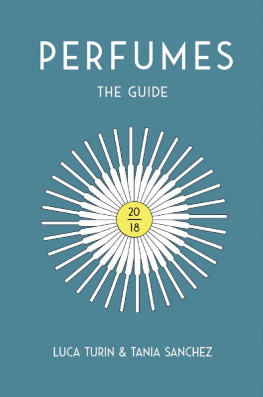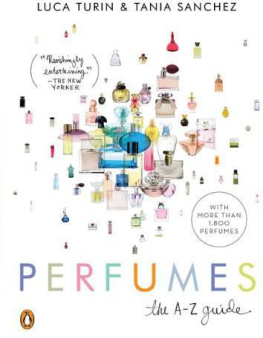THE LITTLE BOOK OF
PERFUMES
THE LITTLE BOOK OF
PERFUMES
THE 100 CLASSICS
LUCA TURIN
&
TANIA SANCHEZ

First published in Great Britain in 2011 by
PROFILE BOOKS LTD 3A Exmouth House
Pine Street
London EC1R 0JH
www.profilebooks.com
First published in the United States of America in 2011 by Viking Penguin, a member of Penguin Group (USA) Inc.
Copyright Luca Turin and Tania Sanchez, 2008, 2011
Most of the reviews in this book first appeared in Perfumes: The AZ Guideby Luca Turin and Tania Sanchez (Profile, 2008)
1 3 5 7 9 10 8 6 4 2
Set in Minion Pro
Designed by Francesca Belanger
Printed and bound in Italy by
L.E.G.O. Spa Lavis (TN)
The moral right of the authors has been asserted.
All rights reserved. Without limiting the rights under copyright reserved above, no part of this publication may be reproduced, stored or introduced into a retrieval system, or transmitted, in any form or by any means (electronic, mechanical, photocopying, recording or otherwise), without the prior written permission of both the copyright owner and the publisher of this book.
A CIP catalogue record for this book is available from the British Library.
ISBN 978 1 84668 519 4
eISBN 978 1 84765 759 6
For the perfumers
CONTENTS
ACKNOWLEDGMENTS
We would like to give an enormous thank-you to Patricia de Nicola, tireless curator of the Osmothque and the great perfumer behind the Parfums de Nicola. Many thanks to all in the perfume industry who helped us this time around, and all the perfume lovers who gave us their support and feedback after the publication of Perfumes: The AZ Guide. Thanks to the good people at the Santa Fe Institute for giving us the perfect place to concentrate on our work, and thanks especially to Janet Rubinstein for enduring all those packages of perfumes. Thanks also to Kathryn Court and all her team at Penguin USA and Peter Carson and all at Profile UK, for proposing this book, and thanks to the marvelous Thomas and Elaine Colchie, terrific agents and even better friends.
AUTHORS NOTE
Perfume formulas are trade secrets. Short of gaschromatograph mass spectrometry, it is impossible, for all practical purposes, to get official confirmation that a formula has been changed and how, though it is easy to get rumors off the record. There is plenty of publicly available information on industry restrictions. We judge changes based on what we smell in side-by-side tests of previous years bottles and new samples, direct from the firms whenever possible.
FOREWORD
by Tania Sanchez
Every buff has a list: the hundred films you must see before dying, the top three cheeseburgers in the northern hemisphere, the ten most overrated paintings, the twenty most idiotic reviews in Perfumes: The AZ Guide, etc. What pleasurable conniptions attend the discovery that someone has ranked Hellboy II above Casablanca or thinks Let It Be trumps Revolver! In fact, probably the best reason to make such a list is the easy satisfaction it provides of infuriating so many with so little effort.
The fragrances reviewed in this book are not the greatest of all timeinstead, they are those that struck us as far above their peers in quality, inventiveness, or straightforward beauty when we surveyed nearly 1,900 during the writing of Perfumes: The AZ Guide, ignoring all publicity, packaging, and the feelings of friends and neighbors and concentrating solely on the scent. This ruled out fragrances that everyone admires except us, and also fragrances that have suffered at the hands of changing formulas. So even if Tabac Blond at its best deserved, in general opinion, to edge out, say, Badgley Mischka, it was not in any shape to argue for itself at the time, so its not in.
This slim, rigorously positive volume also eliminates all fragrances we found less than magnificent: good news for readers who believe if you cant say anything nice you shouldnt say anything at all, and bad news for anyone who despises events in which everyone who turns up gets a prize. So if you want to find out what we thought of Paris Hiltons Can Can, you will have to seek the bigger book.
To make up for our arbitrary, a historical approach and to satisfy the preference of publishers for multiples of ten, we add, to the ninety-six top-ranked fragrances from our previous book, four brief writings on longgone fragrances of historical importance. Our impressions are based on reconstructions, from the original formulas, from the Osmothque, a museum in Versailles devoted to the history of the art of the perfumer. It is not a museum full of pretty crystal, magazine advertisements, and mythologies. It is a place where perfumes sit in cold storage, away from light and abuse, waiting to evaporate up your nose and trigger sensations. We include Franois Cotys Emeraude, LOrigan, and Chypre, plus a possibly perfect composition by Vincent Roubert, Iris Gris. The first three turn up, in various incarnations, frequently at auctions and estate saleslook for older packaging to avoid cheapened recent versions. The last is almost impossible to find, though one lucky woman we know found a pristine full bottle at a flea market with which she taunts everyone. Aside from such serendipitous finds, watch for demonstrations by the Osmothque, in Versailles or by their representation in the United States.
The fact that you can no longer buy these scents as they were intended leads us to the irksome issue of changing formulas. Going against my promise to give only good news, I warn you that many of the fragrances we loved, which untold millions have enjoyed for decades, have changed drastically in the last few years because of aggressive regulation on allergens. That is why we have gone to the trouble of adding recent smelling notes on as many fragrances as we could recheck in time.
I confess that I, as a naturally allergic, itchy, and wheezy person, one of these children who had to take a note to the teacher warning against peanuts, who carries an inhaler and fast-acting antihistamines, and who cannot seem to find a shampoo that does not turn her scalp into a dermatological textbook illustration, am very surprised by the industrys ruthless weeding out of allergens in fine fragrance. After all, my allergy is my problem. I would never demand that other people stop wearing red lipstick because I cant, or cease washing their clothes in enzymatic detergents because they could irritate me. Therefore, I find it very surprising that someone has decided I cannot have my LHeure Bleue ever again because someone else, somewhere, got a red welt. Why cant she wear something else?
This is because every now and then, on a slow news day, an activist group puts out a press release claiming that chemicals found in perfume give you cancer, turn boys into girls, are passed into breast milk, are irritants and sensitizers, and so on. These alarms, often based on effects found at enormous doses, far above amounts you would be exposed to short of falling into a factory vat or drinking the stuff straight, trigger widespread calls to ban perfume. Since perfume is not a toxic, carcinogenic soup and is highly regulated to avoid human or environmental harm, the International Fragrance Association, aka IFRA, needed something to do to prove to the public that they care about health and safety. Therefore, they decided to devote enormous resources to reducing contact dermatitis. And that is why you cant have your old Diorissimo, even if the only reaction you ever had to it was happiness.
Next page


